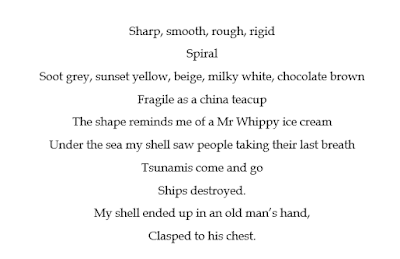Preparation: assemble some shells, ideally enough so the children have one each. They needn't be fancy shells, any ordinary UK sea shells will do.
* Print out some Colour Wheels from here. Be lavish! It's worth the ink if you laminate them to use again and again, because honestly, this colour wheel is one of the most useful tools for creative writing I've come across.
* Make photocopies of the 'My Shell' sheet below.
* You could also provide magnifying glasses for a really thorough examination of the shells.
Delivery: warm the children up by asking them to make a list of things they might see on the ocean bed.
When that's done, give out the shells and let the children examine them for a minute or two. Then ask what they already know about shells. You could tell them:
Shells are made from something similar
to chalk, but harder. They are the armour for molluscs (what is a mollusc?
Oyster, snail, clam, mussel etc). They protect the animal inside and they give
it its shape instead of bones inside the body. Different shapes serve different
purposes: lots of frills, ridges and spines are there as protection. Smooth
shapes enable the animal to escape quickly and burrow down into sand. Some of
our most familiar fossils are of mollusc shells. (Ammonites.) One of the oldest
shell collections was found in Pompeii. Very big shells for sale have often
been taken while the animal was still alive, and then the animal’s been killed,
so try to avoid buying large, fancy shells from shops. Picking up little shells from the
beach is fine.
Ask the children -
1. How do the shells feel under your fingers? (Temperature,
texture? Invite similes.)
2. What patterns can you see? (Similes?)
3. What colours can you see? Use the Colour Wheel to list them.
4. What shape is your shell? (Similes?)
Then ask them to fill in the 'My Shell' sheet. Stress you are not looking for complete sentences because this is poetry.
These notes can then be written up as poems.
Y3
Y4
Y5
Y5
Y5
Y5








No comments:
Post a Comment